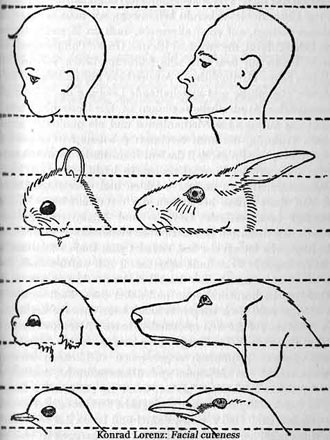Deirdre Barrett
Supernormal Stimuli: How Primal Urges Overran Their Evolutionary Purpose
W. W. Norton
216 pages, 8 1/4 x 6 inches
ISBN 978 0393068481
Supernormal Stimuli explains how our once-helpful instincts get hijacked in our garish modern world. Instincts for food, sex, or territorial protection evolved for life on the savannahs 10,000 years ago—not today’s world of densely populated cities, technological innovations, and pollution.
Nobel Prize-winning ethologist Niko Tinbergen biologists coined the term “supernormal stimuli” in the 1940s to describe imitations that appeal to primitive instincts and exert a stronger pull than the real thing. In his experiments, song birds abandon their pale blue eggs dappled with gray to hop on black polka-dot Day-Glo blue plaster eggs so large they constantly slide off and have to hop back on.
Tinbergen and his students eventually constructed supernormal stimuli for all basic animal instincts—comically unrealistic dummies which an animal will try to mate with or fight with in preference to a real individual if color, shape or markings push their buttons.
These behaviors look funny to us... or sad—the reflexive instincts of “dumb” animals. But then there’s a jolt of recognition: just how different are they from our behavior? In Supernormal Stimuli, I apply this concept to explain most areas of modern human woe.
Animals encounter supernormal stimuli mostly when an experimenter builds them. We make our own, from candy to pornography, from stuffed animals to atomic bombs. We’ve reversed the relationship between instinct and object to manufacture a glut of things which gratify our basic desires with often-dangerous results.
The “good news” in this is that the concept of supernormal stimuli itself—this image of the bird on the day-glo blue egg—can help us realize where we’re going wrong and help our huge brains to kick in and exercise self-control.
We need to “trust our instincts” less and trust our intellect more. Recognizing a supernormal stimulus when we see one is the most important step.

The concept of Supernormal Stimuli is the single most valuable contribution of ethology for helping us understand many issues of modern civilization.
Niko Tinbergen clearly thought ethological principles applied to man. But while waxing eloquently for pages about bee-wasps and sticklebacks, he devoted the occasional sentence or two to man.
The major push to incorporate Darwin into psychology has come under the term “evolutionary psychology.” In their primer, Leda Cosmides and John Tooby are fond of saying that “our modern skulls house a stone age mind.”
Evolutionary psychologists view the brain as a biological computer with circuits which evolved to solve problems faced by humans and pre-human ancestors. Cosmides and Tooby point out that consciousness is a small portion of the contents and processes of the mind. They describe how conscious experience can mislead individuals to believe that that their thoughts are simpler than they actually are. Most problems experienced as easy to solve are actually very complex and are driven and supported by elaborate brain circuitry.
Evolutionary psychologists argue that this is not just another swing of the nature/nurture pendulum. They are not stating as baldly as Tinbergen did in his landmark talk that “Nature is Stronger than Nurture.” Their position instead is that nature/nurture is a false dichotomy: more nature allows more nurture.
In evolutionary psychology, “learning” is not an explanation—it is a phenomenon that requires explanation. Cosmides and Tooby use the example of a larger brained elephant not being able to learn English, not because its brain is less complicated nor even less learning-disposed: elephants have many aspects of memory better than ours. Rather we have evolved specific neural circuits that enable certain types of communication that the elephant has not evolved.
Though sociobiologists and evolutionary psychologists have incorporated many of Niko Tinbergen’s ideas, they have not used the concept of Supernormal Stimuli.
I believe that the concept of Supernormal Stimuli is the single most valuable contribution of ethology for helping us understand many issues of modern civilization. So my book examines a range of human dilemmas from the standpoint of Supernormal Stimuli, interweaving other relevant concepts from all of these evolutionary disciplines.

Most people don’t try to parse cuteness. Like pornography, we know it when we see it. With a bit of examination, however, cuteness has easily quantifiable aesthetics. Take a moment to picture whatever you find cute—puppies, kittens, cartoon characters or your own children. Cuteness is the type of attractiveness associated with youth; your “cute” objects no doubt have many youthful traits.
Infants of most species have a small body with a disproportionately large head, big eyes, small nose, chubby limbs and clumsy coordination. Youthful behavior includes playfulness, affection, helplessness, and a need to be nurtured. A few characteristics such as dimples and baby-talk are unique to humans, but most are common across species.
Evolutionary biologists view “cuteness” as simply the mechanism by which infantile features trigger nurturing in adults—a crucial adaptation for survival. Scientific studies find that definitions of cuteness are similar across cultures. So are our responses.
Anyone disheartened by research demonstrating that attractive adults are better liked and better paid than their homelier peers will be further dismayed at studies on infant cuteness. Articles such as “The Infant’s Physical Attractiveness: Its Effect on Bonding and Attachment” document that stereotypically cute babies receive the most attention from both strangers and their own parents. They run less risk of abuse or neglect. Cute children proceed to get better treatment from teachers. Fortunately, most babies are cute enough to attract sufficient nurturing from parents and the world around them. The decline of cuteness normally coincides with the child’s diminished need for caretaking, which gradually shifts toward younger siblings.
Toy manufacturers are well aware of what’s cute. Dolls have grown progressively cuter: first they looked like people, then like children, then like supernormal exaggerations of children. In the 1990s, the Journal of Animal Behavior published a series of articles on a creature not of the wilderness but of the marketplace.
“The Evolution of the Teddy Bear” traced the origin to 1900 when President Theodore Roosevelt was photographed in the Rockies, after a hunt, with a brown bear in the background. The early teddies looked like bears—with a low forehead and a long snout. Over the years, the teddy “evolved” to become the cute popular creature of now, laden with infantile features, including a larger forehead and a shorter snout. “It is obvious that the morphological changes that have occurred in teddies in the short span of a little over 100 years have contributed greatly to their reproductive fitness,” observed the authors. “There seem to be teddies all over the place.”
With tongue in cheek, but metaphor firmly in mind, animal behaviorists continued publishing on the evolution of the teddy. They pointed out that the changes might be likened to mutation, but are actually closer to “intelligent design,” diverting human resources to enable teddies to reproduce at a phenomenal rate.
Since a teddy bear is often a child’s first toy, one hypothesis that teddy specialists wanted to test was that they evolved to please infants or young children. Researchers offered 4- to 8-year-old children their choice of teddies with adult features or ones with infantile features. The four-year-olds chose the adult-featured bear almost two and a half times more often than the baby-featured bear. Among the older children, 6 to 8 years of age, the babyish teddies were three times more likely to be chosen.
This makes perfect sense. Very young children are the only beings immune to cuteness. What good would it do a baby to attach to other babies? It is clearly in the babies’ interest to attach to adults.
The function of the evolved teddy is to please adults—and older children who are already playing at nurturing. These are the purchasers of toys supposedly bought for infants. And teddies are increasingly bought overtly for adults. Dressed in theme clothing, they are a phenomenon on college campuses.
Babies will hold the standard babyish teddy when they’re not offered the choice of an adult bear. They attach to anything soft and warm, but it’s the tactile resemblance to their mother that draws a very young child to the teddy.

That’s what our giant brains were designed for—overriding reflexive instincts when they start to lead us astray.
We need to begin to engineer our environment back to something more like what we were designed for and also to notice and resist whatever Supernormal Stimuli inevitably remain around us. Collectively we can decide to make our environment more walkable, to tax or even ban junk food, to reduce televisions blaring around us. We can broadcast the opinions, similarity, humanity of people across world, train people to be automatically wary of leaders asking us to fight another group of humans pretty much like ourselves.
Individually, just identifying the supernormal stimuli out there is a crucial first step. We don’t have to just “listen to our instincts,” we can exercise will power—almost a dirty word in these days, but a trainable skill shown to help habitual problems. That’s what our giant brains were designed for—overriding reflexive instincts when they start to lead us astray.
In a world increasingly designed to stimulate hunger, sexual arousal, and acquisitiveness, chasing the supernormal is a losing game. It’s not anti-hedonistic to rein in, or redirect, instincts.
Our pleasure system is robust and very flexible. Scientific studies show that people experience similar levels of happiness long-term regardless of external events. Winning millions in a lottery, or getting paralyzed in an accident—these make a modest difference for six months or less. People in the poorest nations are a couple percentage points less happy than in the most affluent. People who drink, don’t drink, watch TV, don’t watch TV, eat natural vegetables, eat junk food—all experience similar levels of life satisfaction. In fact, the only thing that makes a difference is chronic pain or consistent health crises—things our modern pursuit of supernormal stimuli tend to produce.
The pleasure mechanism can be shaped as to what it responds to—it doesn’t have to be other way around. We understand this more readily when we’re thinking about the evanescent highs of a drug-addicted life vs. pleasure of normal life interactions. But the same is true for diet or social activities or what you find cute.
People get pleasure from what they have gotten used to getting pleasure from. Reward circuits in our brain will respond to the sugar in a handful of tart berries or from the whole cake, to the earned rest after exercise or the whole day on the couch, to real friends dropping by or the simulated laugh-track of a sitcom—all depending on what habits we get accustomed to.
We are the one animal that can notice sitting on a polka-dotted plaster egg—and climb off.




We don't put paywalls. We don't distract you with ads. We don't sell your data.
Please help to keep this running!